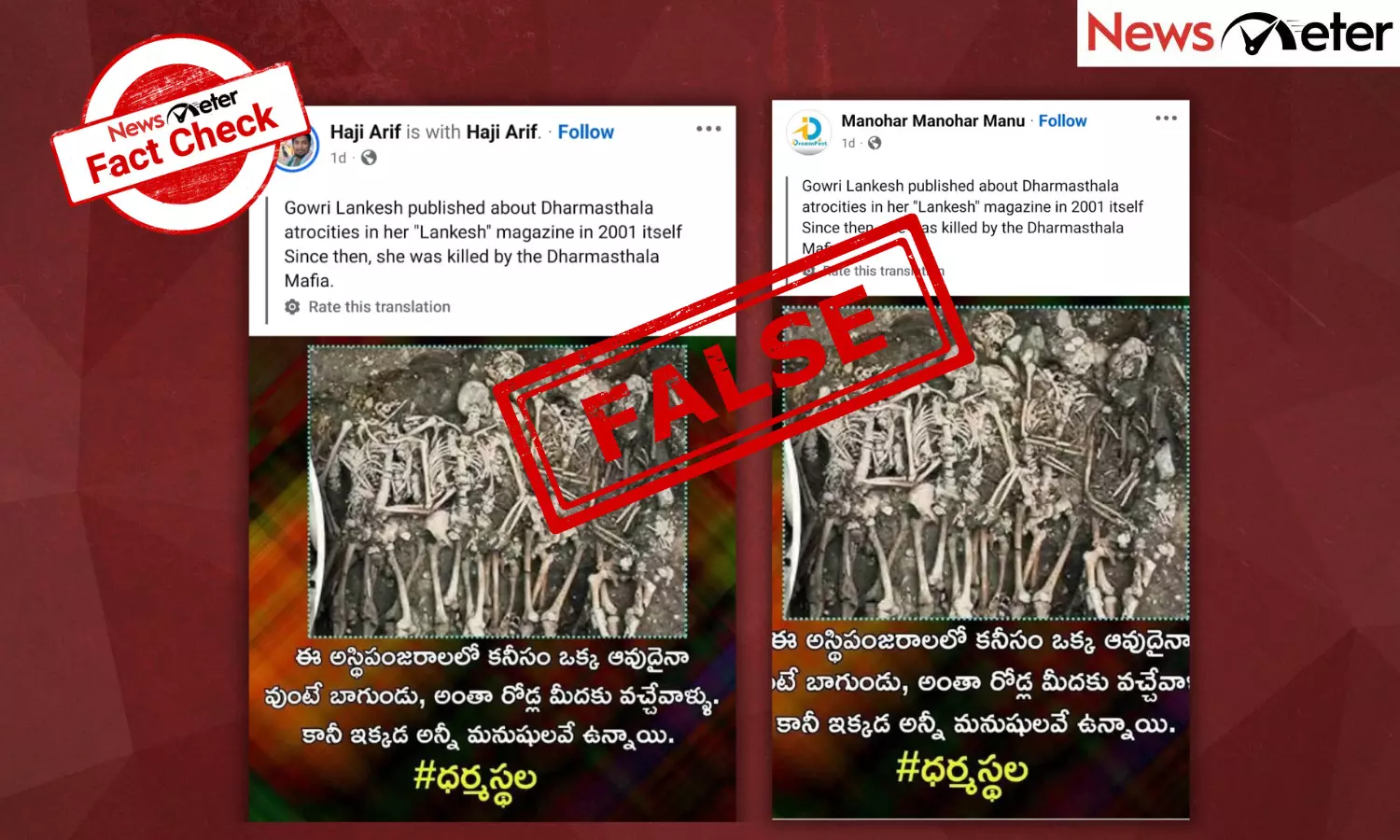Fact Check: Dharmasthala excavations reveal mass burial? Viral image is from France
An image of skeletons being excavated has been circulating online, linking it to the alleged mass burial at Karnataka’s Dharmasthala Temple.
By Md Mahfooz Alam
Claim:The image shows complete skeletal remains found in the recent excavation for alleged victims of ‘Dharmasthala atrocities’.
Fact:The claim is false. The image shows excavation at the Jacobins Convent in Rennes, France, between 2011 and 2013.
Hyderabad: A former sanitation worker has alleged the mass burial of hundreds of women and minors at Karnataka’s Dharmasthala village, claiming many bore signs of sexual assault and violence. The Karnataka government has launched an SIT probe, and skeletal remains have been found at one of the excavated sites.
In this context, an image showing several human skeletons in the process of being excavated has been circulating on social media, suggesting it was taken from one of the excavation sites. The users also allege that journalist Gauri Lankesh had published about the Dharmasthala atrocities in 2001, which led to her killing.
The English translation of the Telugu text on the image reads, “It would have been better if at least one of these skeletons belonged to a cow — but no, they all belonged to people who used to walk the streets. Here, all of them are human. #Dharmasthala”
A Facebook user shared the image with the caption, “Gauri Lankesh had published about the Dharmasthala atrocities as early as 2001 in her 'Lankesh' magazine. Since then, death kept chasing her, and she was ultimately killed by the Dharmasthala mafia.”
Fact Check
NewsMeter found that the claim is false. The image shows excavation at the Jacobins Convent in Rennes, France, between 2011 and 2013.
We conducted a keyword search on the Dharmasthala excavation and came across a report published by The Hindu on July 31.
According to the report, the Special Investigation Team (SIT) probing the alleged mass burials near Dharmasthala found no conclusive evidence at five of the sites. However, at the sixth site, the team discovered partial human skeletal remains. SIT officials confirmed that 15 bones were recovered, some of which were broken, and no skull was found.
However, the viral image shows several skeletons with skulls, confirming that it is not from the recent excavations.
What is the source of the image with the skeletons?
A reverse image search led us to the original, uncropped version of the viral image, which was published by the French news outlet Le Monde on May 5, 2021.
According to the report, the image depicts an archaeological excavation at the Jacobin convent in Rennes, France. It shows the remains of soldiers from the royal army who were buried in one of two mass graves uncovered at the site.
The Le Monde article explained that these skeletons date to the late 15th century and are believed to be the remains of soldiers who died during the Battle of Saint-Aubin-du-Cormier in 1488. The battle was part of the conflict between the Duchy of Brittany and the French crown. The research team, through advanced forensic and archaeological methods, managed to piece together this centuries-old mystery.
We also found the image published in a report by another French media outlet, Le Parisien, dated May 5, 2021.
The report stated that between 2011 and 2013, a team from the French National Institute for Preventive Archaeological Research (INRAP) excavated hundreds of human remains from the Jacobins convent in Rennes, an area historically significant as the site where Brittany’s independence was ultimately lost in the late 15th century.
In collaboration with researchers from the CNRS, the universities of Ottawa, Rennes 2, Toulouse III – Paul Sabatier, and the Max Planck Institute, the team worked to identify the individuals buried in two large mass graves discovered just outside the convent.
According to a study published in the journal PLOS ONE on May 5, 2021, the skeletons are believed to be those of soldiers from opposing armies who perished during the Siege of Rennes in 1491, a pivotal conflict that led to Brittany’s integration into the Kingdom of France.
We found the image in a study published in the journal PLOS ONE on May 5, 2021. It is described as part of an archaeological excavation of a mass grave at the Jacobin convent, dating from the late 14th to the 16th century.
The study is titled, ‘The last battle of Anne of Brittany: Solving mass grave through an interdisciplinary approach (paleopathology, biological anthropology, history, multiple isotopes and radiocarbon dating).’
Did Gauri Lankesh report on ‘Dharmasthala atrocities’?
Finally, we searched whether Gauri Lankesh had reported on the alleged atrocities in Dharmasthala or conducted any investigative exposé related to the region, but found no such report. We also found no evidence linking her murder to any such exposé involving Dharmasthala.
Therefore, we conclude that the image of the excavation in France in 2021 is being falsely linked to SIT probing the alleged mass burials near Dharmasthala in Karnataka.